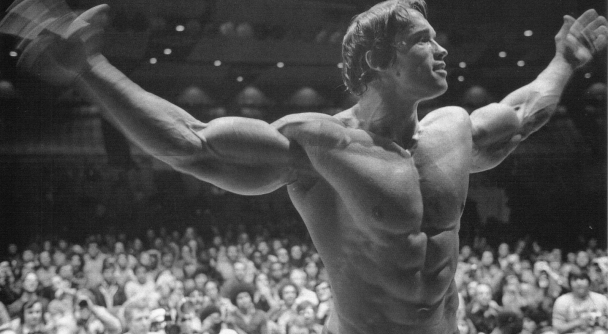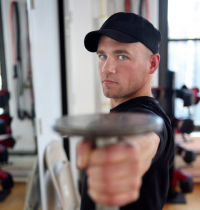Why Do We Get Fat?


By Rob Sulaver
Most people will say we get fat because we eat too much and exercise too little. A surplus of energy = fat gain. If calories-in out number calories-out, we get fatter. This makes sense, because back in 1900something a German dude by the name of Carl von Noorden proclaimed that we get fat because we take in more calories than we expend (1). He was applying the first law of Thermodynamics to the human body.
The 1st Law of Thermodynamics:
In any given system, the energy of the system = the energy supplied to the system - the energy expended by the system.
Let me be clear on this point. This is absolutely TRUE. It’s one of those laws that has stood the test of time. But it’s sorta like this: I walk into a bathroom and see that the bathtub is overflowing with water. So I ask my girlfriend why the tub is overflowing and she says, “Well Rob...it’s overflowing because more water has entered the bathtub than left the bathtub.”
No s***, Sally. Thanks for the information.
It’s like repackaging the what into a more complicated form. I get what’s happening. I want to know why.
I know this seems almost silly, but I believe the real crux of our massive fat-gain problem is that most of our fitness and nutrition advice is based on this over-complication of the what. We’ve noticed that calories-in outnumber calories-out so we desperately attempt to re-balance the math in our favor.
Enter, the 100 calorie snack pack.
This nation (and Nabisco) LOVES The 100 calorie snack pack.
Oreo introduced the 100 Calorie Thin Crisp in 2004. Grocery stores were buzzing with excitement.
“If I only eat 100 calories of Oreos, I’ll get lean,” everyone seemed to think.
According a Brandweek article, Kraft Foods (owner of Nabisco) wracked in $75 million from 100 calorie snack packs in its first year (and the sales data didn’t include Walmart). Of course Kellogg and General Mills quickly caught on and introduced their own 100 calorie snack packs the following year (2).
It didn't take long for science to proven the ineffectiveness of the mini munchie craze. (3) [If you want the cliff notes, a study from 2008 in The Journal of Consumer Research concluded that 100-calorie snackers ate significantly more than regular-sized-potato-chips-bag-eaters who actually exhibited better portion control. Woops. Additional studies have been conducted which substantiate the results.] And still the mini munchie crazy prevails...
Just this past weekend while I was enjoying my Saturday afternoon college football, a commercial informed me that KFC is relaunching their Chicken Little sandwiches. The tag line?
“Little is the new big.”
It turns out that a recent Facebook poll and overwhelming customer demand brought about KFC's decision. The people have spoken: "What we eat isn’t a problem, we just need to eat less of it." *Bows head in shame*
One hundred calorie snack packs and mini chicken sandwiches, of course, aren’t the only thing to blame - it’s just a nice microcosm of our fat accumulation problem. National magazines, credible nutrition and exercise scientists, and next door neighbors offer advice based upon the calories-in/calories-out equation all the freaking time.
“Leave 25% of the food on your plate.”
“Take the stairs instead of the elevator.”
“Park the car farthest from the movie theatre.”
“Wear these shoes (which throw you off balance and make you burn more calories) and you’ll have an amazing butt and thigh in no time.”
But the fact is WE. JUST. KEEP. GETTING. FATTER.
To understand our nation’s fattness, we need a better answer to a rather simple question....
Why do we get fat?
Let’s zoom in and take a look at fat accumulation on a cellular level. To do that, we need to understand what hormones and enzymes regulate our fat tissue.
Eighth grade biology class taught us that hormones are those little chemical messengers inside the body that allow our cells to talk to one another. These hormones are a complicated system. A) They’re highly interdependent so a change in one hormone will effect another. B) They all have different agendas and an entire hierarchy so some hormones will trump others. Tre) They can be disrupted by many things in our environment. 4) They’re constantly changing...constantly...right now...they’re changing. This all makes monitoring and understanding them a challenge. But if we want to talk fat-accumulation, one hormone trumps ‘em all.
Allow me to formally introduce you to Insulin
Let’s say you eat a meal that contains carbohydrates (as we too often do.) These carbs get broken down and into smaller carbs and enter the blood stream in the form of glucose, which is a sugar (aka “blood sugar.”) The body recognizes this spike in blood sugar and starts producing insulin (to be fair, the body has already started producing insulin...just thinking about eating up-regulates insulin production - awesome, no?) This insulin is a hormone - the hormone - that tells your body to remove glucose from the blood and store it as fat.
Más Carbs = Más blood sugar.
Más blood sugar = Más insulin.
Más insulin = Más fat storage.
(That’s right, I’m bilingual.)
Now of course this is an oversimplification of the getting-fat process. Blood sugar isn’t always stored as fat plus protein has an effect on insulin (but it’s markedly less severe.) HOWEVER, as far as oversimplifications go, it’s a pretty useful one.
We need to eat less carbohydrates, to produce less insulin, to store less fat.
Let me say that again. If you want to get lean, you need to eat fewer carbs.
A third time? Manage your carb intake and you’ll be shredded.
Let’s look at the other side of the coin: How do we break fat down?
Allow me to introduce you to Hormone-Sensitive Lipase
Hormone-Sensitive Lipase (HSL) is an enzyme that hangs out in our fat cells. Eighth grade biology class taught us that enzymes....you know what, eighth grade biology class didn’t really teach us much about enzymes. Enzymes are substances inside the body that act as a catalyst to make biochemical reactions occur (4). So this HSL hangs out inside fat cells and breaks down triglycerides (the storage form of fat) into fatty acids (the move-around-the-body form of fat.) This fatty acid can be used directly as energy or be further broken down to create glucose. Yes, the same glucose as carbohydrates. The body does this (constantly) to provide a sort of energy buffer (5).
Here’s the real problema. When insulin levels are elevated, HSL is down-regulated. If HSL drives fat breakdown, insulin cuts the breaks. It makes sense. Insulin levels elevate when our blood is full of sugar (in a normal, healthy body.) Our body doesn’t need to mobilize fat tissue when our system is teeming with energy. When you eat carbs, you breakdown less fat (5).
Zooming back out, we come to a simple conclusion. Fat accumulation, in a large way, can be blamed on a carbohydrate rich diet because those little (tasty) carbs increase fat storage and decrease fat breakdown.
Consume a carbohydrate rich diet and your bathtub starts to overflow.
A qualifier - not all carbs are created equally. Different carbs have different effects on your insulin levels. Different carbs are also packaged very differently. Some come with lots of vitamins and minerals, phytonutrients, pH balancing benefits, fiber, and very few insulin effecting calories. We call these carbs “vegetables." More specifically, "non-starchy vegetables." You know, things like broccoli and brussels sprouts. A low-carb diet never, ever means a low-vegetable diet (again, non-starchy). Vegetables are awesome for you. Infact, it’s hard to overstate just how awesome vegetables are for the human body. Never limit your vegetable intake. Ever.
Another qualifier - If you’re looking for additional science on the getting-fat process, many books have been written on the subject. A good place to start - Gary Taubes - Why We Get Fat And What to Do About It.
A summary. It’s true - too many calories means we’ll get fat. But carbohydrates turn this process on. Limit your carbohydrate intake, store less fat, breakdown more fat. Win, win, win.
If we get 50 comments on this bad boy, I’ll talk about how exercise changes our relationship with carbohydrates.
- (1) Taubes, Gary. Why We Get Fat: Adiposity 101 and the Alternative Hypothesis of Obesity. BioSignature Convention. Las Vegas. Sept 2, 2012.
- (2) Wong, Elaine, Brandweek. 5/25/2009, Vol. 50 Issue 21, p36
- (3) Maura L. Scott, Stephen M. Nowlis, Naomi Mandel, and Andrea C. Morales. “The Effects of Reduced Food Size and Package Size on the Consumption Behavior of Restrained and Unrestrained Eaters” Journal of Consumer Research: October 2008.
- (4) A dictionary. Any dictionary.
- (5) Taubes, Gary. Why We Get Fat And What to Do About It. Anchor Books. New York. 2011.
ABOUT THE AUTHOR

Writer, trainer, coach, sports nutritionist and fitness ninja rockstar Rob Sulaver owns and operates Bandana Training. He dishes out fitness, nutrition, and lifestyle advice with a dash of awesomesauce and glass of ass-kick juice. Rob enjoys strong things like tanks, front squats, and fast twitch muscle fibers. He also loves to cuddle.
Website: http://www.bandanatraining.com/
Facebook: https://twitter.com/bandanatraining
Twitter: https://twitter.com/bandanatraining
